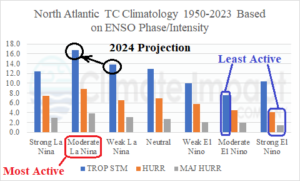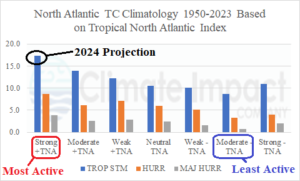El Nino Hanging On Despite Cooling Subsurface
03/25/2024, 10:34 am EDTNorth Atlantic 2024 Tropical Cyclone Season Forecast: Extremely Dangerous Hurricane Season Ahead!
03/28/2024, 12:07 pm EDT
Fig. 1: Renewed seasonal North Atlantic tropical cyclone climatology for 1950-2023 based on ENSO phase using AUG/SEP/OCT operational Nino index (ONI).
Climate Impact Company has renewed seasonal North Atlantic tropical cyclone climatology for 1950-2023 for both El Nino southern oscillation (ENSO) and tropical North Atlantic (TNA) index phase and intensity. The climatology is based on ENSO and TNA index for AUG/SEP/OCT of each year. The ENSO climatology reveals that the most active seasonal activity occurs with moderate La Nina episodes while least active hurricane years are associated with strong El Nino (Fig. 1). In 2024, ENSO is projected to transition from weak to moderate intensity La Nina during AUG/SEP/OCT. TNA index is convenient due to its measurement in the main development region (MDR) for North Atlantic hurricanes located between the eastern edge of the Caribbean Sea and waters off Northwest Africa. Not surprisingly, the strong positive (warm) TNA regime yields the most active tropical cyclone seasons while moderately cool TNA is associated with the least active seasonal activity (Fig. 2). In 2024, record +TNA is likely to continue. During the shift to the warm cycle of the Atlantic multi-decadal oscillation (+AMO) in the late 1990’s, +TNA during AUG/SEP/OCT has occurred each year except 2007, 2002, and 2000. Since 2008, moderate to strong +TNA has occurred in every year except 2018. In 2024, strong +TNA occurs for the 4th time in the past 5 years. Three of the 4 years on record when 20 (or more) tropical cyclones have occurred in one season are from 3 of the past 4 seasons. Given the shift toward moderate La Nina late this year combined with the ongoing record +TNA, more than 20 tropical cyclones for the 2024 season is VERY likely.

Fig. 2: Renewed seasonal North Atlantic tropical cyclone climatology for 1950-2023 based on tropical North Atlantic (TNA) index.
